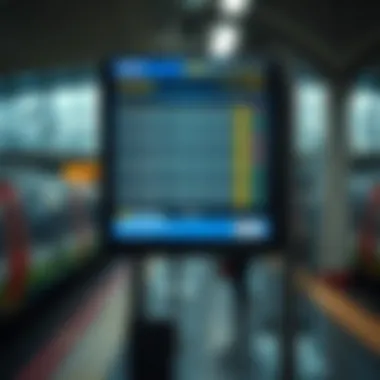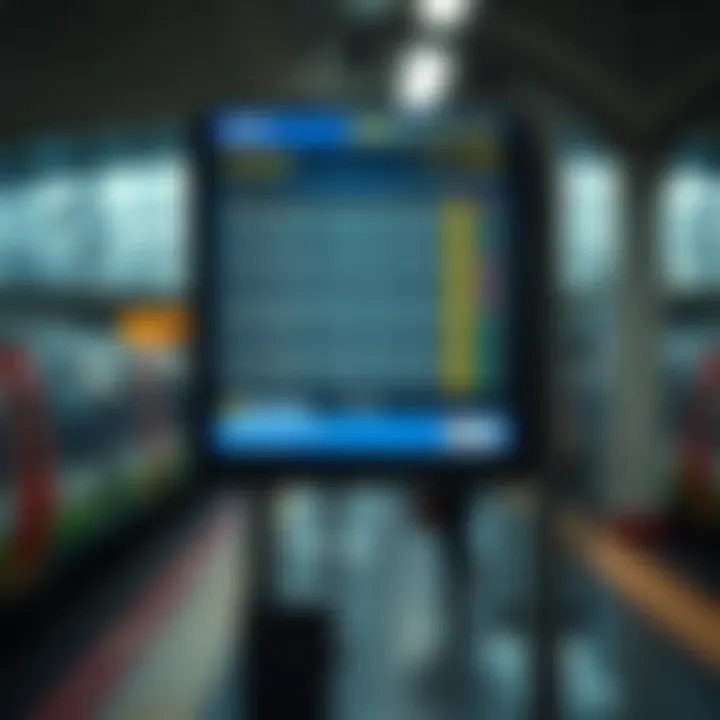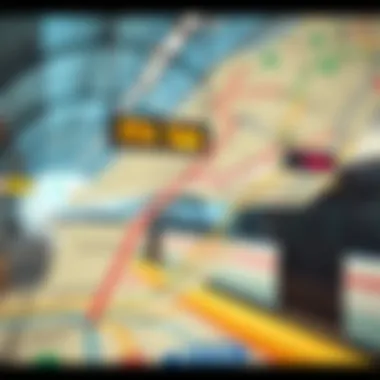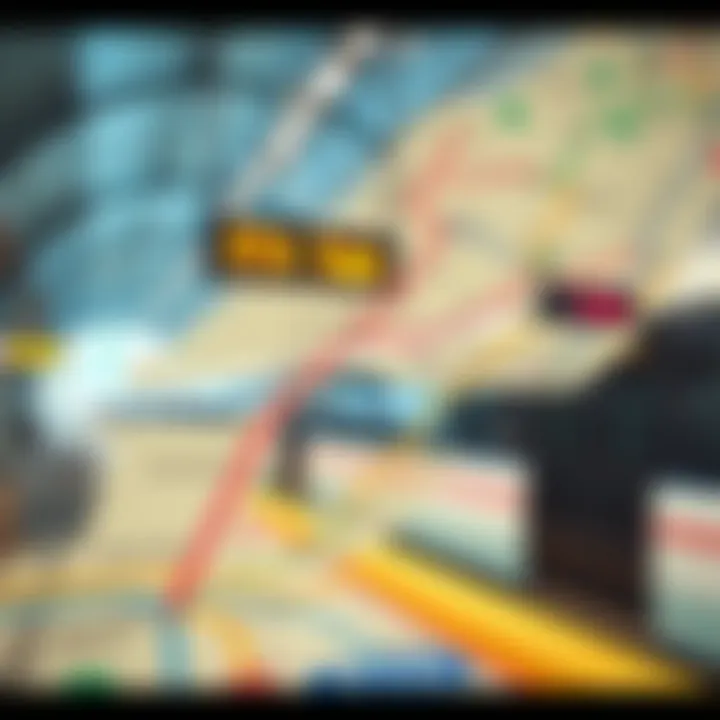Understanding the RTA Train Schedule in Dubai


Intro
Navigating a bustling metropolis like Dubai can feel overwhelming at times, especially for newcomers and visitors unfamiliar with the city's public transport options. One of the most significant elements of this intricate system is the RTA train schedule, a framework that supports the swift movement of people across the city. This narrative aims to shed light on the essential components of the RTA's train schedule, equipping readers with clarity on its structure, functionality, and importance.
Understanding how to effectively utilize the train services can make all the difference in streamlining daily commutes or planning a visit to Dubai's vibrant landmarks. Today, we will delve into various aspects, including operational hours, service frequency, and connectivity with other modes of transport. Furthermore, this guide also addresses some challenges users might encounter on their travels, alongside the strategies to navigate these hurdles. Ultimately, this exploration will not just inform but empower readers to make educated travel choices, ensuring a smoother experience within the city's transport ecosystem.
As we embark on this exploration, keep in mind that knowledge is not just power; it’s convenience in motion. Let's unravel the mesh of the RTA train schedule and the impact it has on the daily lives of both residents and visitors, propelling them throughout Dubai's dynamic landscape.
Preamble to the RTA Train System
The RTA (Road and Transport Authority) train system in Dubai plays a vital role in not just commuting but also in shaping the urban landscape. As the backbone of public transportation, it serves both locals and tourists who navigate the bustling city. With the rapid development of the region, understanding the intricacies of this system is no longer just optional; it has become essential.
For investors and homeowners, the RTA train system offers insights into liveability and transport accessibility in various neighborhoods. Potential buyers often assess how proximity to a train station affects property values and daily convenience. Additionally, expatriates and agents benefit from recognizing how this network facilitates smoother transitions and more efficient commutes.
From operational efficiencies to user experiences, the importance of the RTA train schedule stretches far and wide. Travelers are not only looking for punctuality but also for clarity in scheduling, which directly influences their travel decisions.
Moreover, considerations like the types of routes available, train frequency, and connectivity with other transport systems elevate the discussion around the RTA train services.
- Key Points of Interest:
- Compact but comprehensive service structure that connects vital areas of Dubai.
- Importance of peak vs off-peak scheduling to avoid congestion.
- User-friendly design and conveniences that enhance overall commuter experience.
This journey into the RTA Train System will strive to unpack these elements, painting a complete picture that equips readers with necessary knowledge for effective travel decisions.
Overview of the RTA
Understanding the RTA, or the Roads and Transport Authority, is crucial for anyone navigating the bustling urban landscape of Dubai. This entity is more than just a backbone for transportation; it plays a pivotal role in shaping the daily lives of residents and visitors alike. From the architecturally striking metro stations to the intricate web of bus routes, the RTA encapsulates Dubai’s commitment to modernity and convenience.
The significance of the RTA extends beyond mere transport. It embodies the Emirate's ethos of innovation and sustainability, providing seamless connectivity across the city. With a focus on enhancing the quality of life, the RTA’s services facilitate easy movement for commuters, thereby fostering economic growth and urban development.
A comprehensive look at the RTA reveals several layers of functionality and benefits:
- Efficient Public Transport: The RTA’s integrated transport system not only reduces traffic congestion but also promotes the use of public transport, which is vital in a rapidly growing city.
- Accessibility: The design of the RTA Services ensures that they are accessible to everyone, including those with special needs. This inclusivity is an important aspect of modern urban planning.
- Environmental Considerations: The RTA is committed to sustainable practices, aiming to reduce the carbon footprint associated with transportation in Dubai.
- Technological Integration: From real-time updates on train schedules to mobile payment options: the RTA consistently incorporates cutting-edge technology. This forward-thinking approach enhances user experience and ensures efficient service delivery.
In this exploration of the RTA, we will delve deeper into its history and operational mandate, laying the foundation for understanding the various components that make up the RTA train schedule.
Components of the RTA Train Schedule
The components of the RTA train schedule play a crucial role in ensuring smooth operations and facilitating effective travel options. Understanding these elements can provide valuable insight for residents, tourists, and transit enthusiasts alike. A well-organized schedule is more than just a timetable; it serves as a gateway to accessing a sprawling urban landscape with ease.
In this section, we’ll explore the system design and layout of the RTA train network, along with the various types of trains operated. Each of these components contributes to the overall efficiency and user experience of the transit system.
System Design and Layout
The system design of the RTA train network is expertly crafted to meet the diverse needs of Dubai’s population and its visitors. With various lines spanning the city, the layout emphasizes accessibility and convenience. For instance, major routes are strategically designed to connect key commercial and residential areas, ensuring that passengers can reach their destinations without unnecessary hassle.
A notable feature of the train layout is the integration of escalators, elevators, and clear signage, which significantly enhance accessibility for individuals with disabilities or those carrying heavy luggage. It’s vital to highlight how these design choices reflect a commitment to inclusivity and user-friendliness.
- Interchange Stations: Several stations allow passengers to easily switch between lines, which reduces travel time. Think of stations like Dubai Mall/Burj Khalifa, where commuters can transition fluidly between the Red and Green lines.
- Station Amenities: Train stations are equipped with ticket vending machines, waiting areas, and sometimes even retail outlets. Facilities like these not only add convenience but also contribute to a pleasant commuting experience.
Overall, the system’s layout is dynamic, continually evolving to cater to emerging urban needs. Thus, staying informed about the structure can help riders navigate the system with confidence.
Types of Trains Operated
Within the RTA framework, the types of trains operated are designed to cater to a broad demographic. This means a variety of train models, from high-capacity, fully automated trains to more specialized models, serve different purposes depending on the route they run.
The core of the RTA’s operation includes:
- Red Line Trains: Designed primarily for high passenger volume, these trains are crucial during peak hours, connecting passengers from the northeastern parts of Dubai to its bustling downtown area.
- Green Line Trains: Aimed at bringing commuters closer to cultural sites and residential neighborhoods, these trains help unify various city sectors.
- Specialty Trains: Depending on the requirements, some lines may feature trains designed for specific public events, like the EXPO 2020 celebration, assuring that a large influx of passengers can be accommodated efficiently.
Additionally, RTA often collects feedback on train performance, capacity usage, and commuter comfort. These insights guide how the types of trains are adjusted in response to the requirements of the public.
By understanding these distinctions in train types and overall system design, users can better plan their travel routes and anticipate possible delays or disruptions.
As a commuter, knowing the types of trains and how they are organized can lead to a far less stressful experience on the RTA network.
For more information about the system and design, you may find useful resources through the official RTA website or check out discussions on Reddit.
Understanding Train Timings
Understanding the train timings is not merely a matter of knowing when the next train rolls in. It’s about grasping the intricate dance of operation that affects the daily lives of both residents and visitors in a bustling metropolis like Dubai. Train timings form the backbone of the RTA train service, shaping our day-to-day commutes, influencing travel plans, and providing a reliable means of mobility. By unpacking the schedule, we can appreciate the layers of planning and management that are crucial for an efficient transit system.
When you delve into the daily schedules, you’re not just looking at numbers in a table. You’re recognizing patterns—those sweet spots when the trains run smoothly and the times when the system might feel more crowded than a can of sardines. Moreover, knowing the right times to travel can save you both time and stress.
Daily Schedules


The daily schedules employed by the RTA train system are designed with precision, catering to the rhythm of urban life. Generally, trains operate from early morning around 5 AM until just after midnight, with exact timings varying slightly based on line and day of the week. This allows for flexibility and accessibility, accommodating the needs of commuters who are either heading to or returning from work, school, or leisure activities.
Here are a few key points to consider:
- Frequency of Trains: On average, trains run every 7–10 minutes during peak hours and every 15–20 minutes during off-peak. This means that if you're stuck waiting, it's rarely for long.
- Operational Hours: While some may think the trains run late into the night, it’s essential to keep track of the final train timings. Missing the last train can leave travelers scrambling for alternate transport.
The daily schedule is detailed and transparent, often accessible not just in print at stations but also through mobile applications and the RTA website. For anyone involved in planning a commute, familiarizing oneself with these schedules is vital for an efficient travel experience.
Peak vs. Off-Peak Hours
Differentiating between peak and off-peak hours is akin to navigating through a maze—understanding where the bottlenecks are can greatly improve your journey. Peak hours in Dubai typically range from 7:00 AM to 9:00 AM and 5:00 PM to 7:00 PM. During these times, trains experience a higher influx of passengers, often leading to cramped conditions.
Conversely, off-peak hours usually fall outside of these time frames, particularly late morning and early afternoon, when you can recline and find a seat with more ease. Here’s what makes knowing these hours advantageous:
- Less Crowding: Traveling during off-peak times means you avoid the congestion that habitually plagues rush hour.
- Quicker Boardings: Trains can load and unload more efficiently when there aren’t throngs of people rushing in and out.
- Optimal Timing for Sightseeing: For tourists and local sightseers, planning trips during off-peak hours can lead to a more relaxed experience, allowing you to enjoy the views from the train’s window.
Understanding the train timings and knowing the nuances of peak and off-peak hours is crucial for devising effective travel strategies. It allows not only for planning simplicity but also enhances the overall user experience. > "Knowing when to travel is half the battle in effective commuting."
For further insights, consider visiting the RTA’s official website or engaging in community forums where travelers share tips and advice on train usage.
Real-Time Updates and Notifications
In the ever-accelerating world we live in, where punctuality is more than just a virtue but a necessity, the role of real-time updates and notifications in the RTA train system holds significant weight. Imagine you’re ready to head out for a crucial meeting or catching a flight; the last thing you need is to find out that your train is delayed because of some unforeseen circumstances. With real-time updates, you gain insights that can help you pivot your plans on the fly.
Real-time notifications are more than just a modern convenience; they play a vital role in ensuring seamless travel experiences for both daily commuters and newcomers. The lack of clear information can lead to confusion and stress, often causing riders to miss their connections. Being able to access updated information about train arrivals, delays, and alternate transport options can save time and prevent anxiety. This is especially crucial in a bustling city like Dubai where everyone’s on the go.
Accessing Real-Time Information
Gaining quick access to real-time information is crucial for navigating the RTA train system effectively. Users can utilize several channels to keep themselves updated before and during their journeys. The official RTA website is a reliable source, featuring an interactive map and latest schedule adjustments. You can check train arrivals, departures, and even service interruptions directly from your computer or mobile device.
Many passengers find that keeping an eye on social media platforms, especially Twitter and Facebook, helps stay informed about operational updates. The RTA often posts alerts regarding service changes or unexpected delays, and following them on these channels could be well worth your time. Furthermore, announcements within train stations and on trains themselves also provide crucial information. It is advisable to pay attention to these as they allow passengers to make informed decisions while on the move.
Mobile Applications for Convenience
In today's tech-savvy era, mobile applications serve as a lifeline for commuters looking to navigate their travel smoothly. The RTA has developed user-friendly mobile apps that provide not only real-time train information but also various features designed to heighten the commuting experience.
With the RTA's official app, users can plan their journey in a few taps by checking train schedules, looking up fares, or even buying tickets. Users can also set personalized notifications, receiving alerts on train arrival times and service disruptions directly to their smartphones. This ensures that no one is left in the lurch during a busy day.
Moreover, apps like Google Maps integrate RTA information, offering a seamless way to combine different modes of transportation, whether that's connecting to a bus or a taxi. Passengers can explore various routes and receive live updates, providing an overview that helps them adapt their travel plans quickly.
"The ability to adapt your journey in a moment's notice means less stress and more control over your day."
Route Details and Connectivity
Understanding the details surrounding train routes and connectivity represents a foundational aspect of utilizing the RTA train schedule in Dubai. It links not just disparate points within the city, but also interconnects various transport modes that cater to the needs of residents and visitors alike. This layered connectivity enhances the effort to create a sustainable urban transport environment, nourishing the city’s bustling economy and cultural fabric through improved mobility.
Key Routes and Destinations
The RTA train system in Dubai boasts a well-structured network that encompasses key routes, each strategically designed to provide access to major destinations.
- Red Line: By far the longest line, stretching from Rashidiya to UAE Exchange, this route plays a significant role in connecting various suburbs to the city's central business areas. Notable stops include Deira City Centre and Burj Khalifa.
- Green Line: Running from Etisalat to Dubai Creek, this line may be shorter, but it dives deep into areas rich in history and culture. Visitors often hop on this line to explore vibrant neighborhoods and cultural landmarks.
- Transitioning to Other Modes: Many of the train stations are purposefully integrated with bus routes and tram lines, yielding a seamless transfer experience. There are well-marked signs guiding passengers from the train platform to their next ride, making commutes smooth and efficient.
Communities that lie along these routes often flourish due to the improved access to key commercial hubs, educational institutions, and leisure activities. For expatriates researching living or investing decisions, an awareness of these routes can inform choices about proximity to workplaces or social amenities.
Intermodal Connections
Intermodal connections within the RTA framework serve as the vital arteries of its transport network, ensuring that commuters have access to multiple forms of transit beyond the train itself.
- Bus Services: Numerous bus routes are synchronized with train schedules, ensuring that passengers can transition between different modes with minimum wait time. Buses usually wait in proximity to train stations, allowing for a natural flow of movement as commuters disembark.
- Tram Links: The proximity of tram lines to specific train stations brings another layer of efficiency. Some routes are directly linked, enabling a direct transfer without a complicated navigation process.
- Water Taxis and Ferries: For those looking for a more scenic route, connections to water transport services exist as well. These further facilitate access to areas such as Dubai Marina and the historic Al Seef, ensuring commuters enjoy beautiful views while traveling.
- Unified Fare Systems: Also of note is the unified fare system that allows ease of payment across different transport modes. A single NOL card can be utilized on the train, bus, tram, and even water taxis, making travel much simpler.
The depth of RTA's transport connections not only helps in mitigating urban congestion but also encourages a lifestyle where reliance on personal vehicles is minimized.
"RTA's comprehensive plan for integration signifies a forward-thinking approach to urban mobility, creating a system that considers both immediate transit needs and future city growth."
For further exploration:
- Official RTA Website: RTA
- Wikipedia on Dubai Metro: Dubai Metro
- Reddit discussions on RTA: Reddit
Fares and Ticketing System
Understanding the fare and ticketing system is crucial for anyone using the RTA train service in Dubai, whether a resident or a visitor. It directly influences how easily one can navigate through the city and impacts overall travel costs. The transparency and efficiency of this system can greatly enhance the commuting experience, ensuring people make informed choices regarding their travel.
Ticket Types and Pricing
When it comes to ticketing, the RTA has designed a system that's both user-friendly and flexible, catering to a wide variety of commuters. Here’s an overview of the ticket types available:
- Red Nol Card: This is perfect for occasional users. It's a single-use card that can be used for trips on trains, buses, and water transport. The cost depends on the zones you travel through.
- Silver Nol Card: Recommended for regular commuters, this card allows unlimited travel within specified zones. You can load it with varying amounts based on individual needs.
- Gold Nol Card: An exclusive card giving holders access to the Gold Class cabins on the metro for a more luxurious experience. This card comes with a premium pricing structure.
- Personalized Nol Card: For residents who frequently travel, this card offers added benefits, such as discounts on certain trips.


In terms of pricing, the fare varies depending on the zones crossed during the journey. For example, traveling within one zone may cost as little as 3 AED, while crossing multiple zones might escalate the fare to 7.5 AED or more. It's advisable for commuters to understand the zoning system thoroughly in order to anticipate costs effectively.
Payment Methods
The RTA has made strides in ensuring payment for tickets is as hassle-free as possible. Here are the main modes of payment:
- Online Recharge: Commuters can conveniently top up their Nol cards via the RTA app or on the RTA website. This flexibility allows users to recharge their cards from anywhere, at any time, without the need to queue at a kiosk.
- Ticket Machines: Located at train stations, these machines accept cash and card, providing another quick way to purchase tickets.
- Retail Outlets: Numerous locations around the city, such as convenience stores and supermarkets, also sell Nol cards and allow on-the-spot recharges.
Important Note: Keeping your Nol card balance topped up is key to avoiding delays or confusion while traveling. A minimum balance of 7.5 AED is often required to enter the metro stations.
All these payment methods ensure accessibility for everyone. They cater not only to locals but also to tourists visiting the dynamic city of Dubai, providing them with several ways to access transportation without much fuss.
Safety and Security Measures
Safety and security are paramount when navigating the RTA train system in Dubai. With thousands relying on this service daily, the emphasis on effective safety protocols cannot be overstated. Understanding the measures in place not only enhances passenger confidence but also fosters a culture of communal safety. The RTA has put extensive effort into ensuring that both travelers and the infrastructure are safeguarded.
Onboard Regulations
Within the RTA trains, certain regulations are established to maintain a secure environment. These include rules against eating and drinking, which help minimize mess and ensure cleanliness. Furthermore, passengers are discouraged from leaning against train doors or engaging in disruptive behavior. This set of protocols aims to preserve a serene atmosphere conducive to efficient travel.
Some key regulations include:
- No Loud Music: To keep the peace, loud noises are discouraged to not disturb other travelers.
- Bicycles and Strollers: Guidelines exist regarding the transport of bicycles and strollers, specifying when and where they can be taken.
- Personal Space: Passengers are encouraged to be vigilant about their surroundings and respectful toward others' personal space.
These regulations resonate with the broader objective of safeguarding travelers and ensuring a system that operates seamlessly.
Emergency Protocols
In the event of an emergency, the RTA has established a comprehensive protocol designed to prioritize the safety of passengers. The key to effective emergency response lies in preparation and awareness. Trains are equipped with mechanisms for immediate communication in times of crisis, ensuring that the relevant authorities can act swiftly.
Emergency protocols include:
- Evacuation Routes: Clearly marked signs indicate evacuation routes, ensuring that passengers know how to exit swiftly in case of an emergency.
- Emergency Alarms: Each train features an alarm system that can alert staff and emergency services if needed. Passengers are trained to use these alarms appropriately to signal trouble.
- First Aid Kits and Trained Staff: Onboard staff receive training in basic first aid, and first aid kits are readily available for swift response during incidents requiring medical attention.
"Having a well-structured emergency protocol is akin to having a safety net; it may not always be visible, but its presence brings peace of mind to all passengers."
These measures are not simply regulatory; they represent the RTA's commitment to maintaining a secure travel environment. Passengers, in turn, should familiarize themselves with these protocols as part of their travel routine, as being informed is a significant step towards achieving personal safety.
As the RTA continues to grow and evolve, the belief in prioritizing the safety and security of passengers remains an unwavering cornerstone.
Challenges Faced by RTA Train Users
Understanding the challenges encountered by RTA train users is crucial for several reasons. Firstly, it sheds light on the real-world issues that commuters face daily, which directly impacts their travel experiences. Secondly, acknowledging these obstacles can lead to better solutions, enhancing the overall effectiveness and efficiency of the RTA train services. Furthermore, exploring these challenges helps various stakeholders, including investors, government bodies, and city planners to grasp user sentiments, ensuring that the system evolves to more effectively meet the needs of residents and visitors alike.
Common Complaints
Most RTA train users generally have a few common complaints that reflect underlying issues with the service. Some frequent grievances include:
- Crowded Train Cars: During peak hours, users often find the trains overcrowded, leading to discomfort and longer boarding times. Many commuters report feeling cramped, which can deter regular use of the service.
- Inconsistent Timings: While the RTA usually maintains a reliable schedule, occasional delays can disrupt plans. Users have expressed concern regarding unforeseen hold-ups, which create confusion and frustration.
- Limited Coverage: Although the RTA train network has expanded significantly, some areas remain underserved. Passengers traveling from less-accessible neighborhoods may find it challenging to reach train stations, impacting their ability to use rail services efficiently.
- Inadequate Information Display: Commuters rely heavily on real-time notifications and information displayed at the stations. However, some users have noted that this information can sometimes be unclear or updated slowly, resulting in missed connections.
"Public transport should be a seamless experience, but it often feels like a game of chance due to these common pitfalls."
Suggestions for Improvement
To address these challenges, several actionable suggestions can be made:
- Enhancing Capacity During Peak Hours: Increasing train frequency during rush hour could mitigate issues of overcrowding. Implementing longer train configurations could also help optimize available space.
- Improving Real-Time Information Systems: It's essential for RTA to invest in more accurate and timely information displays. This could include upgrading existing systems to ensure updates happen in real-time, preventing confusion around delays or cancellations.
- Expansion of Train Routes: Further expanding the train network would alleviate limited coverage concerns. Creating new routes to connect underserved areas into the main network could enhance accessibility, encouraging more residents to utilize train services.
- Creating User Feedback Channels: Establishing better channels for users to voice their feedback would enable the RTA to address complaints more effectively. This feedback could lead to tailored changes based on what users feel would enhance their experience.
Implementing these suggestions could not only address existing grievances but also foster a more user-friendly environment within the RTA train system, encouraging widespread and consistent use.
The Role of the RTA in Urban Mobility
The Roads and Transport Authority (RTA) plays a pivotal role in shaping urban mobility within Dubai, a city renowned for its rapid growth and modern infrastructure. The efficiency of public transport systems, such as the RTA train services, not only enhances connectivity but also supports the city's vision for sustainable development. This section explores the various ways in which the RTA contributes to urban mobility, emphasizing its initiatives that promote a robust, user-friendly transit framework.
Sustainability Initiatives
In a world increasingly focused on environmental impact, the RTA has made strides in incorporating sustainability into its operational ethos. These initiatives include:
- Energy Efficient Trains: The RTA operates trains that utilize advanced technology, reducing energy consumption and greenhouse gas emissions. The commitment to renewable energy sources ensures that the trains run with a minimal carbon footprint.
- Green Certification: The authority actively pursues green certifications for its projects, encompassing facilities and rolling stock that adhere to international environmental standards.
- Encouraging Public Transport Usage: By offering affordable, reliable, and accessible train services, the RTA promotes public transport as an alternative to personal vehicles, thereby decreasing traffic congestion and pollution. The strategic placement of stations encourages higher ridership, making public transport a viable option for residents and visitors alike.
These measures exemplify the RTA's dedication to fostering an eco-friendly transit system that not only serves its immediate users but also contributes to the broader sustainability goals of the city.
Future Developments
Looking ahead, the RTA has outlined ambitious plans to further enhance urban mobility. Some of the anticipated developments include:
- Expansion of Train Lines: The RTA aims to expand its existing train network, with new lines designed to connect underserved areas of Dubai, thereby improving access to central hubs.
- Integration with Smart Technologies: Future developments also include the integration of cutting-edge technologies, such as artificial intelligence and IoT solutions, to enhance user experience and optimize bus and train schedules. This integration not only eases commuting but also provides users with real-time updates regarding their journeys.
- Autonomous Train Systems: Research and development into autonomous trains promise to revolutionize train travel, leading to safer, more efficient operations. Although still in early stages, the adoption of such systems will characterize the RTA's commitment to futuristic transit solutions.


In summary, the RTA's role in urban mobility encompasses an array of initiatives aimed at enhancing transit efficiency and sustainability. As developments unfold, these strategies will not only answer residents' needs but also set new precedents in urban planning and transportation.
Comparative Analysis with Other Transport Systems
Understanding how the RTA train system stacks up against other transport systems is crucial for several reasons. An analysis of this nature provides insight into efficiency, user satisfaction, and the effectiveness of urban mobility solutions. It allows stakeholders to pinpoint strengths and weaknesses, improving the overall experience. Moreover, it equips commuters and city planners with knowledge about alternative options, fostering a more informed travel ecosystem.
Regional Transport Solutions
In the context of the Middle Eastern region, many cities have invested heavily in their public transport systems, spearheading initiatives similar to that of the RTA in Dubai. Consider the Dubai Metro, for instance. It boasts advanced technology and a user-centric approach, almost paralleling the systems in cities like Abu Dhabi and Doha.
- Abu Dhabi has been developing its transport infrastructure with emphasis on integrating various modes of transport. The capital is working on expanding its bus networks and is also planning to introduce rail links, which complement the overall regional connectivity.
- In Doha, the Doha Metro is another sophisticated network that mirrors RTA's operational efficiency and user engagement strategies. The similarities highlight best practices that can be shared and adopted across urban transport systems in the region, improving service delivery.
Benefits of analyzing these regional systems include:
- Benchmarking performance metrics such as on-time reliability and passenger volumes.
- Observing how neighboring cities handle urban challenges, such as congestion and environmental sustainability.
By examining these regional initiatives, stakeholders get a clearer picture of potential collaborations and shared innovations that could benefit RTA's operations.
Global Comparisons
Taking a broader view, comparing Dubai's RTA train system with those of cities worldwide provides a fascinating landscape of urban transport solutions. Global cities like Tokyo, London, and New York present diverse models and lessons that can enhance the RTA's strategies.
Tokyo, for example, is renowned for its punctuality and intricate train systems. The Japan Railways Group operates an extensive network known for its ease of use, which is bolstered by advanced technology that provides real-time updates to users.
- London's Tube is another case point, with a vast network that requires continuous investment for upgrades and maintenance. Their user engagement through various mobile applications and social media channels serves as an inspiring model for RTA to enhance its own user interaction.
- In New York, the Metropolitan Transportation Authority offers interesting fare structures and various types of passes, ensuring flexibility for everyday commuters.
By comparing global transport solutions, one can observe the importance of:
- Technology Adoption: Many successful systems leverage technology to optimize operations and enhance user experience.
- User Experience: Engagement methods and customer service practices from these cities offer valuable insights into making RTA train users feel appreciated.
- Sustainability Practices: Looking at how global competitors address environmental concerns can inform RTA’s future sustainability strategies.
In summary, a thorough analysis of how RTA stands against regional and global transport frameworks can unveil opportuities for enhancement and collaboration, ultimately leading to improved service for passengers in Dubai.
End: Summarizing Key Insights
The conclusion of this article serves as a synthesis of the comprehensive exploration into the RTA train schedule in Dubai. By unpacking the intricate details of the system, we highlight its significance in facilitating urban mobility, which is essential for both residents and visitors alike.
Importance of Clear Train Scheduling
First and foremost, a clear train schedule is critical. It shapes every commuter's experience and influences efficiency in travel plans. Whether one is a daily commuter or a tourist, understanding the train timings not only saves time but also enhances overall satisfaction with the transport service. Having reliable information on peak and off-peak hours allows users to plan their journeys accordingly, thus avoiding unnecessary delays. \n
Benefits of Integrated Transport Systems
Moreover, the interconnectedness of the RTA's train system with other modes of transportation cannot be overstated. This structure supports seamless transitions between different transit options, including buses and taxis. A well-coordinated schedule ensures minimal waiting times and maximizes convenience. Commuters can rely on a smooth flow from one transport mean to another, making the entire travel experience more pleasant.
Addressing Challenges and Future Developments
While understanding the schedule is pivotal, it’s also important to acknowledge the challenges faced by users. From overcrowding to service delays, these issues can undermine the benefits of the RTA system. However, addressing these challenges through user feedback and system improvements stands as a crucial consideration for the future.
Final Thoughts
In closing, the RTA train schedule is more than just a set of numbers and times; it's a reflection of an evolving urban landscape. By grasping the dynamics of the schedule, one gains insight into how this transport system contributes to Dubai's vibrant life. Investments in efficiency and technology will pave the way for an even more connected and user-friendly experience in the years to come.
"A reliable train schedule is not just a convenience - it’s a lifeline for urban living."
For those interested in diving deeper into this subject, resources such as RTA's official website and community discussions on Reddit can provide additional insights and updates.
Resources for Further Information
Having access to reliable resources is crucial for anyone wanting to navigate the RTA train schedule effectively. In today’s fast-paced world, up-to-date information can make or break a travel experience, especially in a bustling city like Dubai. Thus, knowing where to find reliable information allows travelers—be they residents or visitors—to make better decisions, avoid unnecessary delays, and enhance their overall commuting experience.
Official RTA Website
The official RTA website serves as the cornerstone for finding comprehensive and accurate details about the train schedule. Here, users can access:
- Real-time Train Timings: This feature allows passengers to check the status of trains in real-time, helping them make timely connections.
- Service Updates: The site publishes any service changes or disruptions that could affect travel.
- Interactive Map: A tool that illustrates train routes and station locations, which can be quite helpful for first-time travelers.
- In-depth FAQs: These clear up common questions regarding fares, operational hours, and more.
Utilizing the official website not only assists users in planning a smoother journey, it also provides transparency about operational strategies and any potential changes in service. It's a one-stop shop for all information related to the RTA train services.
Visit the Official RTA Website: RTA Official Site
Community Forums
Engaging in community forums can provide insights that official sources often overlook. Many forums, such as Reddit or dedicated Facebook groups, allow users to share their personal experiences. Here, travelers can discuss:
- Tips for Travelers: Locals often share hidden gems about using public transportation which are not found in official channels.
- Updates on Service Issues: Fellow commuters may report problems they encounter, allowing others to adjust their travel plans accordingly.
- Advice on Off-Peak Travel: Insights into which trains are less crowded typically come from frequent users.
These exchanges create a communal knowledge base, making it beneficial for both new and seasoned travelers. By participating in these discussions, you can stay informed about practical, real-world factors that influence your journey.
Join Community Discussions on: Reddit RTA Discussions
"Staying connected with other travelers enhances the experience—an informed traveler is often a happy one."
In summary, combining the precision of the official resources with the insights gleaned from community forums equips travelers with a well-rounded understanding of the RTA train schedule, ensuring they are not just passengers but informed participants in Dubai’s dynamic transport system.



